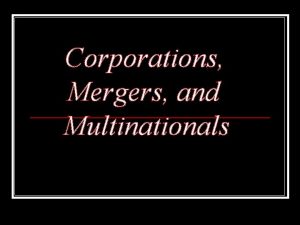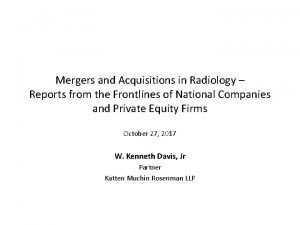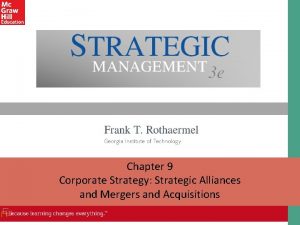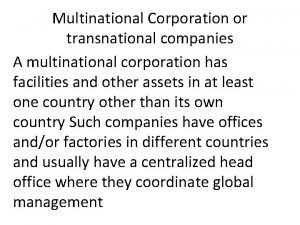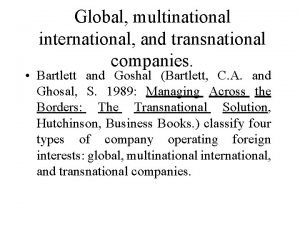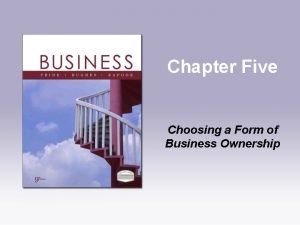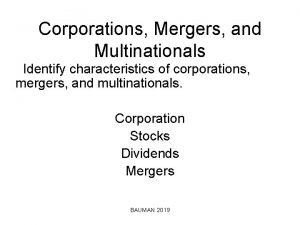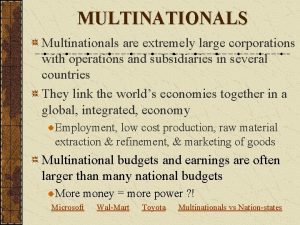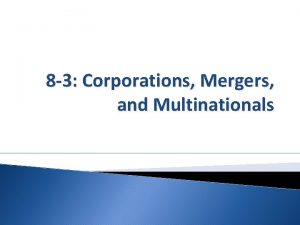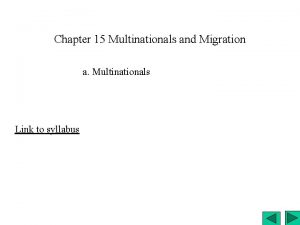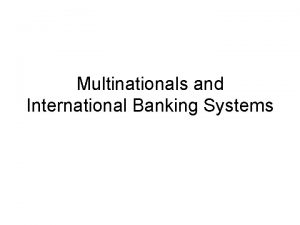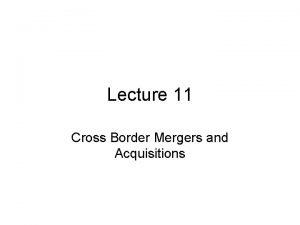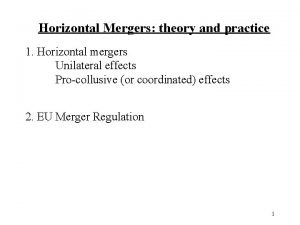Corporations Mergers and Multinationals 8 3 notes What















- Slides: 15

Corporations, Mergers, and Multinationals 8. 3 notes • What types of corporations exist? • What are the advantages of incorporation? • What are the disadvantages of incorporation? • How can corporations combine? • What role do multinational corporations play? Chapter 8 Section Main Menu

Types of Corporations • A corporation is a legal entity, or being, owned by individual stockholders. • Stocks, or shares, represent a stockholder’s portion of ownership of a corporation. • A corporation which issues stock to a limited a number of people is known as a closely held corporation. • A publicly held corporation, buys and sells its stock on the open market. Chapter 8 Section Main Menu

Advantages of Incorporation Advantages for the Stockholders Advantages for the Corporation • Individual investors do not carry responsibility for the corporation’s actions. • Corporations have potential for more growth than other business forms. • Shares of stock are transferable, which means that stockholders can sell their stock to others for money. • Corporations can borrow money by selling bonds. • Corporations can hire the best available labor to create and market the best services or goods possible. • Corporations have long lives. Chapter 8 Section Main Menu

Disadvantages of Incorporation • Corporations are not without their disadvantages, including: Difficulty and Expense of Start-Up Corporate charters can be expensive and time consuming to establish. A state license, known as a certificate of incorporation, must be obtained. Double Taxation Corporations must pay taxes on their income. Owners also pay taxes on dividends, or the portion of the corporate profits paid to them. Loss of Control Managers and boards of directors, not owners, manage corporations. More Regulation Corporations face more regulations than other kinds of business organizations. Chapter 8 Section Main Menu

Corporate Combinations • Horizontal mergers combine two or more firms competing in the same market with the same good or service. • Vertical mergers combine two or more firms involved in different stages of producing the same good or service. • A conglomerate is a business combination merging more than three businesses that make unrelated products. Chapter 8 Section Main Menu

Multinationals Advantages of MNCs Disadvantages of MNCs • Multinationals benefit consumers by offering products worldwide. They also spread new technologies and production methods across the globe. • Some people feel that MNCs unduly influence culture and politics where they operate. Critics of multinationals are concerned about wages and working conditions provided by MNCs in foreign countries. Multinational corporations (MNCs) are large corporations headquartered in one country that have subsidiaries throughout the world. Chapter 8 Section Main Menu

Section 3 Assessment 1. All of the following are advantages of incorporation EXCEPT (a) the responsibility for the business is shared (b) capital is easier to raise than in other business forms (c) corporations face double taxation (d) corporations have more potential for growth 2. A horizontal merger (a) combines two or more firms involved in different stages of producing the same good or service. (b) combines two or more partnerships into a larger partnership. (c) combines two or more firms competing in the same market with the same good or service. (d) combines more than three businesses producing unrelated goods. Want to connect to the PHSchool. com link for this section? Click Here! Chapter 8 Section Main Menu

Section 3 Assessment 1. All of the following are advantages of incorporation EXCEPT (a) the responsibility for the business is shared (b) capital is easier to raise than in other business forms (c) corporations face double taxation (d) corporations have more potential for growth 2. A horizontal merger (a) combines two or more firms involved in different stages of producing the same good or service. (b) combines two or more partnerships into a larger partnership. (c) combines two or more firms competing in the same market with the same good or service. (d) combines more than three businesses producing unrelated goods. Want to connect to the PHSchool. com link for this section? Click Here! Chapter 8 Section Main Menu

Other Organizations 8. 4 notes • How do business franchises work? • What are three types of cooperative organizations? • What are nonprofit organizations? Chapter 8 Section Main Menu

Business Franchises • Franchisers develop products and business systems, then local franchise owners help to produce and sell those products. • Franchises allow owners a degree of control, as well as support from the parent company. A business franchise is a semi-independent business that pays fees to a parent company in return for the exclusive right to sell a certain product or service in a given area. Chapter 8 Section Main Menu

Advantages and Disadvantages of Business Franchises Advantages of Business Franchises Disadvantages of Business Franchises • Management training and support • High franchising fees and royalties • Standardized quality • Strict operating standards • National advertising programs • Purchasing restrictions • Financial assistance • Limited product line • Centralized buying power Chapter 8 Section Main Menu

A cooperative is a business organization owned and Cooperatives operated by a group of individuals for their shared benefit. • Consumer Cooperatives – Retail outlets owned and operated by consumers are called consumer cooperatives, or purchasing cooperatives. Consumer cooperatives sell their goods to their members at reduced prices. • Service Cooperatives – Cooperatives that provide a service, rather than goods, are called service cooperatives. • Producer Cooperatives – Producer cooperatives are agricultural marketing cooperatives that help members sell their products. Chapter 8 Section Main Menu

Nonprofit Organizations: exempt from federal income taxes Professional Organizations Professional organizations work to improve the image, working conditions, and skill levels of people in particular occupations. Trade Associations Nonprofit organizations that promote the interests of particular industries are called trade associations. Business Associations Business associations promote the business interests of a city, state, or other geographical area, or of a group of similar businesses. Labor Unions A labor union is an organized group of workers whose aim is to improve working conditions, hours, wages, and fringe benefits. Institutions that function like business organizations, but do not operate for profits are nonprofit organizations. Nonprofit organizations are exempt from federal income taxes. Chapter 8 Section Main Menu

Section 4 Assessment 1. A business franchise (a) attempts to improve the image and working conditions of people in a particular occupation. (b) operates without the aim of profit. (c) is a semi-independent business tied to a parent company. (d) is not required to pay income taxes. 2. Consumer cooperatives (a) are owned and operated by consumers. (b) provide a service, rather than a good. (c) help members sell their agricultural products. (d) pay no income tax. Want to connect to the PHSchool. com link for this section? Click Here! Chapter 8 Section Main Menu

Section 4 Assessment 1. A business franchise (a) attempts to improve the image and working conditions of people in a particular occupation. (b) operates without the aim of profit. (c) is a semi-independent business tied to a parent company. (d) is not required to pay income taxes. 2. Consumer cooperatives (a) are owned and operated by consumers. (b) provide a service, rather than a good. (c) help members sell their agricultural products. (d) pay no income tax. Want to connect to the PHSchool. com link for this section? Click Here! Chapter 8 Section Main Menu
 Corporations mergers and multinationals
Corporations mergers and multinationals What are mini multinationals
What are mini multinationals Radiology mergers and acquisitions
Radiology mergers and acquisitions Hr issues in mergers and acquisitions
Hr issues in mergers and acquisitions Franchise mergers and acquisitions
Franchise mergers and acquisitions Corporate restructuring
Corporate restructuring Chapter 4: merger strategy
Chapter 4: merger strategy Mergers and acquisitions rumors
Mergers and acquisitions rumors Non equity alliance
Non equity alliance Gregor andrade
Gregor andrade What is mergers and acquisitions
What is mergers and acquisitions Aqa merger of
Aqa merger of Multinational vs transnational corporations
Multinational vs transnational corporations Difference between global company and multinational company
Difference between global company and multinational company Learnnowbiz
Learnnowbiz Disadvantages of corporations
Disadvantages of corporations
